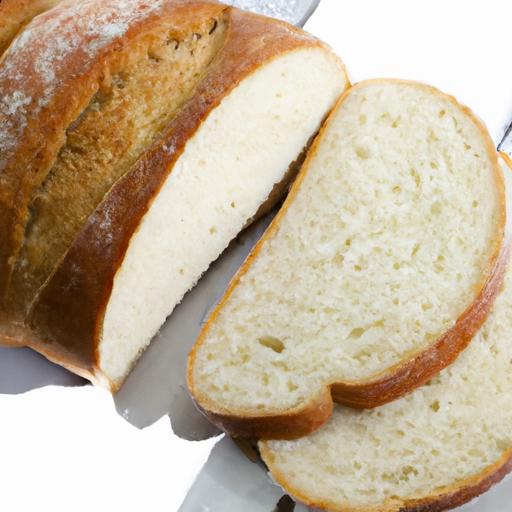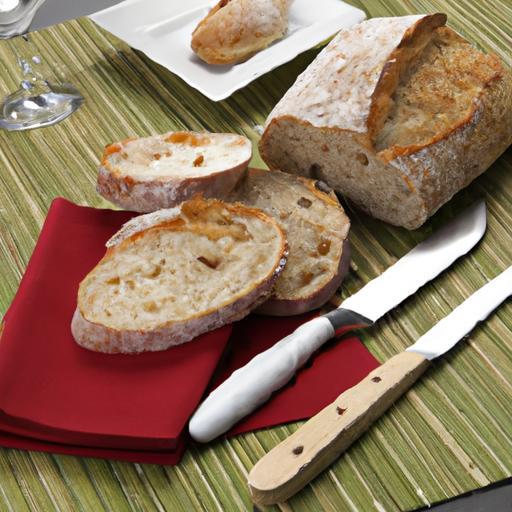There’s nothing quite like the comforting aroma of freshly baked bread wafting through your kitchen-a simple pleasure that can brighten any meal. Yet, as quickly as that joy arrives, it often fades when your favorite loaf succumbs to the dreaded fuzz of mold. But what if you could unlock the secrets to preserving that perfect crust and soft crumb a little longer? Welcome to your ultimate guide on keeping bread fresh longer, where smart tips and clever tricks join forces to prevent mold growth and extend every slice’s delicious life. Say goodbye to wasted loaves and hello to fresher, tastier bread-day after day.
Understanding What Causes Bread to Mold Quickly
Keep Bread Fresh Longer starts with knowing why bread molds so fast. Mold thrives in warm, moist environments where airborne spores find nourishment. Most store-bought breads contain preservatives, yet natural humidity, temperature fluctuations, and improper storage invite microbial growth. High moisture content in bread and exposure to air accelerate mold formation. Improper packaging, frequent handling, or storing in non-breathable containers trap moisture and speed spoilage. By grasping these root causes, you empower yourself to safeguard your loaves.
Optimal Storage Conditions to Extend Bread Freshness
Creating ideal conditions is key to extending your bread’s freshness. Keep Bread Fresh Longer by storing bread at room temperature, ideally between 65°F and 75°F, away from direct sunlight or heat sources that increase condensation. Use breathable paper bags or cloth bread bags to balance moisture and airflow. Avoid plastic bags unless refrigerated, which preserves bread but may alter texture.
For long-term storage, freezing bread at tightly wrapped portions locks in freshness without encouraging mold. Always slice before freezing for quick thawing and to avoid moisture condensation.
Natural Preservatives and Homemade Solutions to Inhibit Mold
Nature provides brilliant tools to inhibit mold without chemicals. Sprinkling a touch of vinegar – a natural antifungal – on a paper towel inside your bread container gently lowers surface pH. Similarly, a cotton pouch with food-grade baking soda absorbs excess moisture, reducing mold risk.
Another time-honored solution is incorporating a small amount of vinegar or lemon juice into homemade bread dough. These acidic agents slow microbial growth while imparting a subtle tang for depth of flavor.
Smart Habits to Maintain Bread Quality Day After Day
Handling bread with care ensures a longer life span. Always slice bread with a clean, serrated knife and avoid exposing unsliced portions to air. Store partial loaves tightly wrapped in wax paper or beeswax wraps to maintain humidity balance without suffocating your bread.
Rotate your bread stock: consume older bread first and limit buying in bulk unless freezing. Check for condensation or mold daily and discard bread that shows signs of spoilage immediately to prevent cross-contamination.
Prep and Cook Time
- Prep Time: 10 minutes (for storage prep and homemade preservative application)
- Cook/Baking Time (for homemade bread): 25-30 minutes
Yield
- Preserves freshness for up to 7 days (room temperature)
- Freezing extends freshness for up to 3 months
Difficulty Level
Easy – Suitable for all bread lovers and kitchen novices
Ingredients
- 1 teaspoon distilled white vinegar (natural antifungal agent)
- 1 tablespoon lemon juice (optional, for homemade dough)
- Food-grade baking soda (for moisture absorption)
- Wax paper, parchment paper, or beeswax wrap (for wrapping)
- Cloth bread bag or paper bag (for breathable storage)
Instructions
- Prepare your storage environment: Place a folded paper towel lightly sprayed with vinegar at the bottom of your bread container or bag to deter mold spores.
- Wrap your bread: If slicing, wrap partially sliced loaves in wax paper, then loosely cover with a breathable cloth or paper bag to allow air circulation.
- Control moisture: Add a small cotton pouch filled with baking soda inside the bread storage container to absorb excess moisture. Replace every 1-2 weeks.
- Freeze extra bread: Slice the bread before freezing in airtight freezer bags. Remove as many air pockets as possible and thaw slices as needed.
- Optional homemade bread tip: When baking your own bread, incorporate 1 tablespoon of lemon juice alongside your wet ingredients to naturally improve preservation without affecting flavor.
Chef’s Notes
- Ensure your vinegar-towel is lightly damp but not wet, preventing sogginess or an overpowering smell.
- If bread becomes stale, revive by lightly misting with water and warming in a preheated oven at 350°F for 5-7 minutes.
- Experiment with essential oils such as rosemary or thyme in baking for natural preservation and enhanced aroma.
- Always observe the surrounding area’s humidity; excessive indoor moisture will reduce storage efficacy.
Serving Suggestions
Present your fresh bread sliced thick or thin depending on preference. Garnish with a sprinkling of sea salt or spread with homemade herb butter to enhance natural flavors. Serving alongside freshly brewed soups or vibrant salads elevates a simple bread experience into an inviting, comforting meal.
| Nutrient | Per Slice (30g) |
|---|---|
| Calories | 80 kcal |
| Protein | 2 g |
| Carbohydrates | 15 g |
| Fat | 1 g |
For more on homemade bread care, check out our detailed guide.
For scientific insights on mold growth in baked goods, visit NCBI Mold Growth Study.

Q&A
Q&A: Keep Bread Fresh Longer – Smart Tips to Prevent Mold Growth
Q1: Why does bread go moldy so quickly?
A1: Bread is a moisture-rich, nutrient-packed environment – the perfect playground for mold spores floating in the air. When these spores land on bread, especially in warm and humid conditions, they multiply rapidly and turn your loaf fuzzy and unappetizing in no time.
Q2: What’s the best way to store bread to keep mold at bay?
A2: The holy grail of mold prevention is cool, dry, and dark storage. Keep your bread in a paper bag or a breathable bread box on the counter. These options balance moisture control and air circulation, so your bread’s crust stays nice while mold has less chance to thrive.
Q3: Can refrigeration help prevent mold on bread?
A3: Refrigeration slows mold growth but also accelerates bread staling, making it dry and crumbly. If your kitchen is hot and humid, refrigerate your bread wrapped tightly in plastic or a sealed bag to protect it from moisture-but be ready to toast or warm it up before enjoying.
Q4: How about freezing bread? Is it a good idea?
A4: Absolutely! Freezing bread is one of the smartest hacks – it halts mold growth completely and preserves freshness for weeks. Slice before freezing so you can pop out exactly what you need without thawing the whole loaf. Just thaw at room temperature or toast straight from the freezer.
Q5: Are there any natural tricks to keep bread fresh naturally?
A5: Yes! Placing a celery stalk or an apple slice inside your bread bag can help retain moisture without encouraging mold. These natural moisture regulators keep the bread soft and fresh a little longer, but remember to replace them regularly to avoid their own spoilage.
Q6: Should I ever keep bread in plastic bags?
A6: Plastic bags trap moisture, which can lead to mold growth faster if stored at room temperature. However, if you live in a dry climate and plan to eat the bread quickly, plastic bags sealed tight can actually help keep bread soft. Just avoid letting condensation build up inside the bag.
Q7: How can I tell when bread is still safe to eat?
A7: Mold appears as fuzzy, discolored spots in shades of green, white, blue, or black. Even if there’s just a tiny patch, it’s best to toss the entire loaf – mold roots can permeate deeper than you see. Always trust your nose; a sour or off smell is a moldy bread red flag.
Q8: Can any bread be stored longer than usual?
A8: Artisan breads with thick crusts and lower moisture levels tend to resist mold better than soft, highly processed sandwich breads. Sourdough’s natural acidity is also a mold deterrent, giving it a longer shelf life without preservatives.
Q9: What should I do if I bought more bread than I can eat soon?
A9: No need to waste! Slice and freeze extra bread immediately. Alternatively, transform stale slices into croutons, bread crumbs, or French toast to extend their life creatively before they spoil.
Q10: Does humidity in the kitchen affect bread freshness?
A10: Huge impact! High humidity encourages mold spores to flourish. Using a dehumidifier or storing bread in cooler, less humid spots like a pantry away from the stove can make a big difference in keeping your loaf mold-free longer.
Keep these tips close, and say goodbye to that moldy loaf surprise. Bread is a little miracle of daily comfort – treat it wisely, and it will reward you with freshness every morning!
In Conclusion
Keeping your bread fresh longer doesn’t have to be a daily struggle. By embracing a few smart habits-like storing bread in the right environment, choosing the proper packaging, and knowing when to freeze-you can extend the life of your loaf and reduce waste. Mold may be relentless, but with these simple, science-backed tips, you can outsmart it and enjoy your bread at its best, slice after perfect slice. So, next time you bring home a fresh loaf, remember: a little care goes a long way in keeping mold at bay and your bread delightfully fresh. Happy eating!








